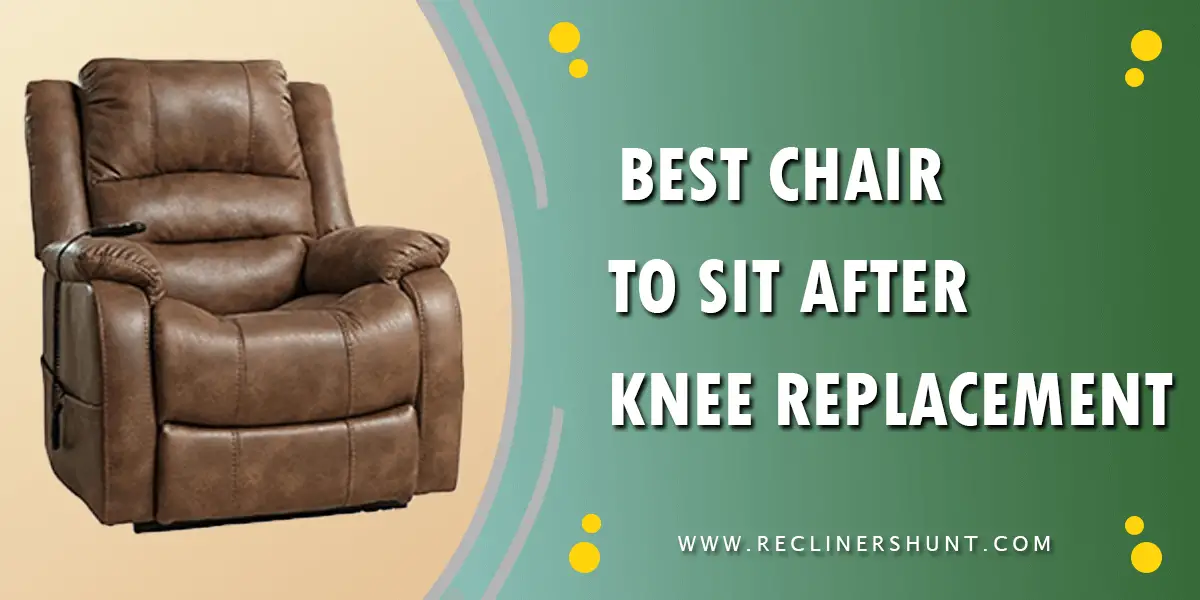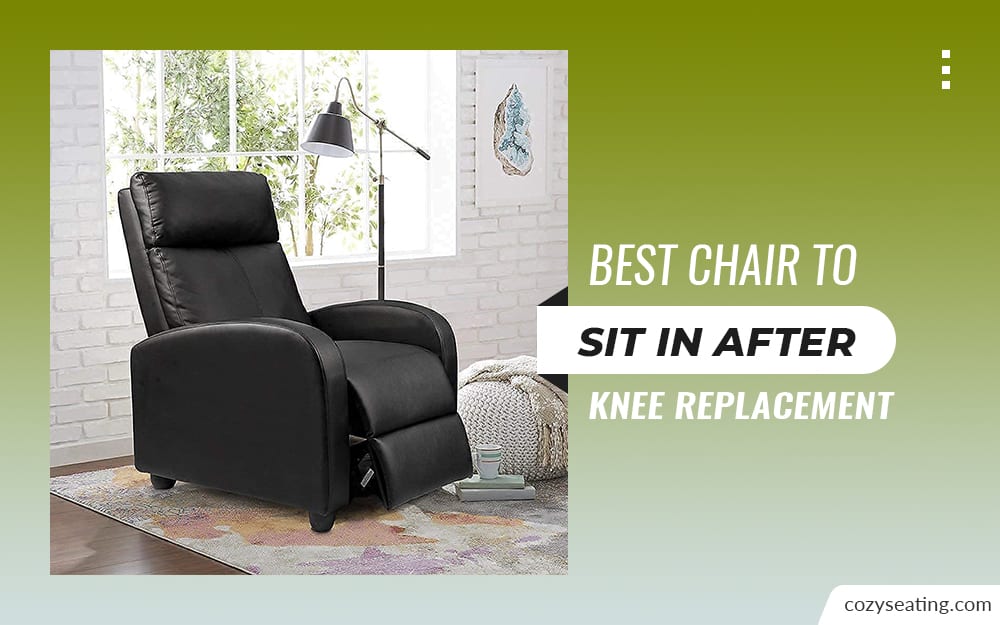Understanding Knee Replacement Recovery and Seating Needs

Knee replacement surgery is a significant procedure that requires a substantial recovery period. Understanding the typical recovery stages and the challenges patients face when sitting is crucial for choosing the right chair to support their healing process.
Recovery Stages and Seating Needs
After knee replacement surgery, patients typically go through several stages of recovery, each presenting unique challenges and seating needs.
- Immediate Post-Surgery (Hospital Stay): During this initial stage, patients are often confined to bed and require a hospital bed with adjustable height and a supportive backrest.
- Early Recovery (Home): Once discharged from the hospital, patients need chairs that promote proper posture, minimize strain on the knee, and facilitate standing up and sitting down.
- Intermediate Recovery: As mobility improves, patients need chairs that allow for flexibility and ease of movement, such as adjustable height and armrests for support.
- Late Recovery: In this stage, the focus shifts towards strengthening and regaining full mobility. Chairs with adjustable features and good lumbar support are ideal for maintaining a healthy posture and promoting proper recovery.
Challenges Faced by Knee Replacement Patients When Sitting
Knee replacement patients often face several challenges when sitting, including:
- Pain and Swelling: Post-surgery pain and swelling can make it difficult to sit comfortably and for extended periods.
- Limited Flexibility: Reduced range of motion in the knee can make getting in and out of chairs challenging.
- Weak Muscles: Weakened leg muscles can make it difficult to stand up from a chair without assistance.
- Posture Issues: Improper seating can strain the back and neck, leading to discomfort and further hindering recovery.
Factors to Consider When Choosing a Chair for Knee Replacement Recovery
Selecting the right chair is crucial for a comfortable and effective recovery. Several factors should be considered:
- Height and Seat Depth: The chair should be the right height to allow for easy sitting and standing. The seat depth should be adequate to provide support without putting pressure on the knee.
- Armrests: Armrests provide support when getting in and out of the chair, reducing strain on the knee. They should be at the right height and angle to support the arms comfortably.
- Backrest: A supportive backrest is essential for maintaining proper posture and minimizing strain on the back. It should be adjustable to allow for comfortable positioning.
- Seat Cushioning: Adequate cushioning provides comfort and reduces pressure on the knee. The cushioning should be firm enough to provide support but soft enough to be comfortable.
- Stability: A stable chair is essential for preventing falls and injuries. The chair should have a wide base and a non-slip surface.
- Ease of Movement: The chair should be easy to move around the house, especially during the early stages of recovery when mobility is limited.
- Adjustability: Adjustable features, such as height and backrest angle, allow for customization to suit individual needs and changing mobility levels.
Chair Features for Optimal Comfort and Support

Choosing the right chair after knee replacement surgery is crucial for promoting comfort, reducing pain, and facilitating healing. The right chair will provide adequate support and allow for proper posture, minimizing strain on the recovering knee.
Adjustable Height
Adjustable height is a fundamental feature for knee replacement patients. The chair’s height should allow for a comfortable sitting position with the feet flat on the floor and the knees at a 90-degree angle.
A chair that is too low will force the knees to bend at an uncomfortable angle, while a chair that is too high will put pressure on the lower back.
An adjustable height chair allows for personalized positioning, accommodating individual leg lengths and ensuring proper posture during recovery.
Seat Depth, Best chair after knee replacement
The seat depth of a chair is also important for comfort and support. The seat should be deep enough to provide adequate back support, but not so deep that it puts pressure on the back of the knees.
A general guideline is that the seat depth should be about two-thirds the length of the thigh, allowing for a small gap between the edge of the seat and the back of the knees.
This gap prevents pressure on the back of the knees and allows for proper blood circulation.
Back Support
A chair with good back support is essential for maintaining proper posture and reducing strain on the spine. The back support should be firm and contoured to the natural curve of the spine, providing lumbar support and preventing slouching.
Look for chairs with adjustable backrests that can be customized to fit your individual needs and provide the optimal level of support.
Armrests
Armrests provide stability and leverage when getting in and out of the chair. They also help to reduce strain on the shoulders and back, making it easier to sit and stand comfortably.
Choose chairs with armrests that are at a comfortable height, allowing for easy arm placement without straining the shoulders.
Seat Firmness
The firmness of the chair seat is another important factor to consider. A chair that is too soft can cause the body to sink in, putting pressure on the recovering knee.
A chair that is too firm can be uncomfortable and may not provide adequate support.
The ideal seat firmness will provide adequate support without feeling too hard or too soft.
Examples of Chair Designs
Several chair designs incorporate these features for optimal comfort and support for knee replacement patients.
- Recliners: Recliners are popular choices after knee replacement surgery. They offer adjustable positions, allowing you to elevate your legs and reduce swelling. Look for recliners with a footrest that extends fully, providing ample leg support.
- Lift Chairs: Lift chairs are specifically designed for individuals with mobility limitations. They use a motor to lift the user to a standing position, reducing strain on the knees and back.
- Adjustable Office Chairs: Many office chairs offer adjustable features, including height, seat depth, and back support. These chairs can be a good option for home use, providing comfort and support while working or relaxing.
Types of Chairs for Knee Replacement Recovery: Best Chair After Knee Replacement

Choosing the right chair after knee replacement surgery is crucial for your comfort, support, and overall recovery. The ideal chair should provide proper positioning, minimize strain on your knee joint, and facilitate easy movement.
Armchairs
Armchairs are a common choice for relaxation and can be suitable for knee replacement recovery, particularly those with high backs and supportive armrests.
- Pros: Armchairs provide a comfortable and familiar seating experience. They can offer good back support and armrests that can aid in standing up and sitting down. Some models feature adjustable heights and reclining options, enhancing comfort and support.
- Cons: Standard armchairs might not provide the necessary elevation for optimal knee positioning. The lack of specialized features like lift mechanisms can make standing up and sitting down challenging.
Recliners
Recliners offer a wide range of adjustable positions, allowing you to customize the angle of your back and legs for optimal comfort and support.
- Pros: Recliners can be adjusted to elevate your legs, reducing swelling and pain in your knee. The ability to recline provides a comfortable position for resting and promotes relaxation.
- Cons: Some recliners may be difficult to maneuver, requiring effort to adjust the position. The reclining mechanism can be bulky, taking up significant space in your living area.
Lift Chairs
Lift chairs are specifically designed to assist with standing up and sitting down, making them ideal for individuals recovering from knee replacement surgery.
- Pros: Lift chairs feature a motorized mechanism that gently raises you to a standing position, reducing strain on your knee joint. They typically have adjustable backrests and footrests, allowing you to find a comfortable position.
- Cons: Lift chairs are generally more expensive than standard armchairs or recliners. They require electrical outlets for operation and can be bulky, taking up considerable space.
Specialized Chairs
Beyond standard chair types, there are specialized chairs specifically designed for post-knee replacement recovery.
- Pros: These chairs often incorporate features like adjustable heights, swivel bases, and specialized cushions to provide optimal support and comfort. They can be customized to meet individual needs and preferences.
- Cons: Specialized chairs can be more expensive than other options. They might not be readily available at all furniture stores and may require specific customization.
Finding the best chair after knee replacement can be a challenge, as comfort and support are paramount. If you’re looking for a chair that promotes good posture and reduces pressure on your knees, a kneeling chair might be a great option.
You can find a comprehensive guide to the best kneeling chair 2019 to help you make an informed decision. While kneeling chairs may not be suitable for everyone, they can offer a unique and comfortable alternative for those seeking improved posture and reduced knee strain.
Finding the best chair after knee replacement can be a challenge, as you need something supportive and comfortable to help with recovery. A chair with good lumbar support and adjustable height is essential, and if you’re also dealing with sacroiliac joint pain, consider looking for a chair that offers additional pelvic support.
You can find some great recommendations for best office chairs for sacroiliac problems that can also be helpful for knee replacement recovery.
